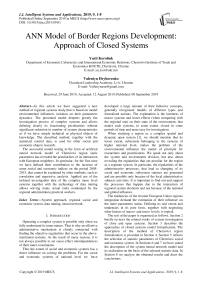ANN model of border regions development: approach of closed systems
Автор: Yurii Koroliuk, Valentyn Hryhorenko
Журнал: International Journal of Intelligent Systems and Applications @ijisa
Статья в выпуске: 9 vol.11, 2019 года.
Бесплатный доступ
In this article we have suggested a new method of regional systems study that is based on model environmental influences isolation on their parameters dynamics. The presented model deepens greatly the investigation process of complex systems and allows defining clearly its functioning peculiarities without significant reduction in number of system characteristics as if we have simple technical or physical objects of knowledge. The described method, together with the statistical control data, is used for other social and economic objects research. The successful model testing in the form of artificial neural network model of Chernivtsi region static parameters has revealed the peculiarities of its interaction with European neighbors. In particular, for the first time we have defined their contribution to the increase of some social and economic indices on the period 2005-2015, that cannot be explained by other methods, such as correlation and regressive analysis. Applied use of the isolated investigation idea of the complex meso level systems together with the technology of data mining allows solving many actual tasks nominated by the regional administration practical workers.
System approach, regional social and economic system, data mining, neural network
Короткий адрес: https://sciup.org/15016618
IDR: 15016618 | DOI: 10.5815/ijisa.2019.09.01
Список литературы ANN model of border regions development: approach of closed systems
- Hudec Oto, Nataša Urbančíková, “Systemic approach to regional planning” // 3rd Central European Conference in Regional Science CERS – 2009. – P. 357–368, 2009.
- Bertalanffy L., “General system theory: foundations, development, applications”. – N.Y.: G. Braziller, 1969. – 289 p., 1969.
- Herman Haken, “Information and Self-Organization: A Macroscopic Approach to Complex Systems”, (3rd enlarged ed.). – 2006. – P. 262, 2006.
- U. Beyer and F. Smieja, “Data exploration with reflective adaptive models,” Computational Statistics Data Analysis, vol. 22, pp. 193–211, 1996.
- Samuel E., Knockaert L. and Dhaene T., “Multipoint Model Order Reduction Using Reflective Exploration”. – In Book: Scientific Computing in Electrical Engineering. – pp.1-2, 2016.
- MacKinnon, D., Cumbers A.; Pike A., Birch K., and McMaster, R., “Evolution in economic geography: Institutions, political economy, and adaptation”. Economic Geography 85:129–50, 2009.
- Forrester, J. W., “System dynamics, systems thinking, and soft OR”. System Dynamics Review, 10, 245–256, 1994.
- Mole K., “Systems theory and the common-sense view of advisers”, Journal of Small Business and Enterprise Development, Vol. 11 No. 1, pp. 114–20, 2004.
- Ye, L., and Wu, A. M., “Urbanization, Land Development, and Land Financing: Evidence from Chinese Cities”. Journal of Urban Affairs, 36(sup1), 354–368, 2014.
- Liu, S., Yang Y., Xie N., and Forrest J., “New progress of Grey System Theory in the new millennium”. Grey Systems: Theory and Application, 6(1), 2–31, 2016.
- Zhang B., Qiao H., Chen Z. M., and Chen B., “Growth in embodied energy transfers via China’s domestic trade: Evidence from multi-regional input–output analysis”. Applied Energy, 184, 1093–1105, 2016.
- Flegg A. T., and Tohmo T., “Estimating Regional Input Coefficients and Multipliers: The Use of FLQ is Not a Gamble”. Regional Studies, 50(2), 310–325, 2014.
- Basse R. M., Omrani H., Charif O., Gerber P., and Bódis K., “Land use changes modelling using advanced methods: cellular automata and artificial neural networks. The spatial and explicit representation of land cover dynamics at the cross-border region scale”. Applied Geography, 53, 160–171, 2014.
- Bersini H. De., “l'intelligence humaine_a l'intelligence artificielle”. Ellipses Editions, 2006.
- Nielsen R. H., “Kolmogorov’s Mapping Neural Network Existence Theorem”. // Proceedings of the IEEE First International Conference on Neural Networks. – San Diego. – 1987. – P. 11–13, 1987.
- Caruana S., Lawrence, and L. Giles, “Overtting in neural nets: Backpropagation, conjugate gradient, and early stopping”. In Advances of Neural Information Processing Systems, volume 13, pages 402–408, 2001.


